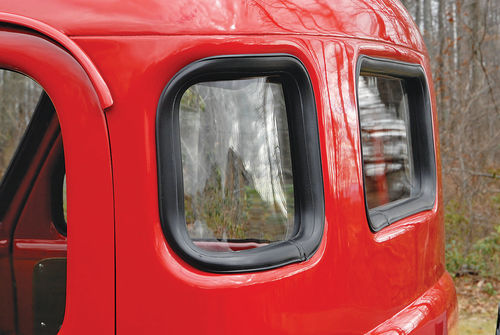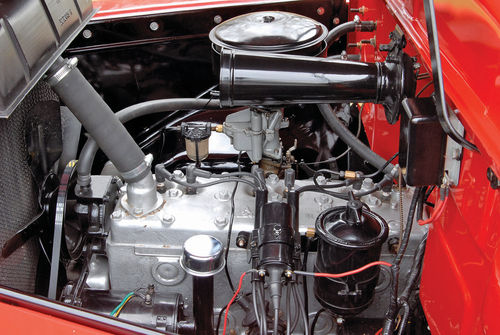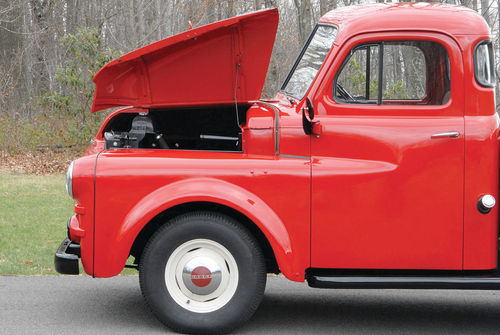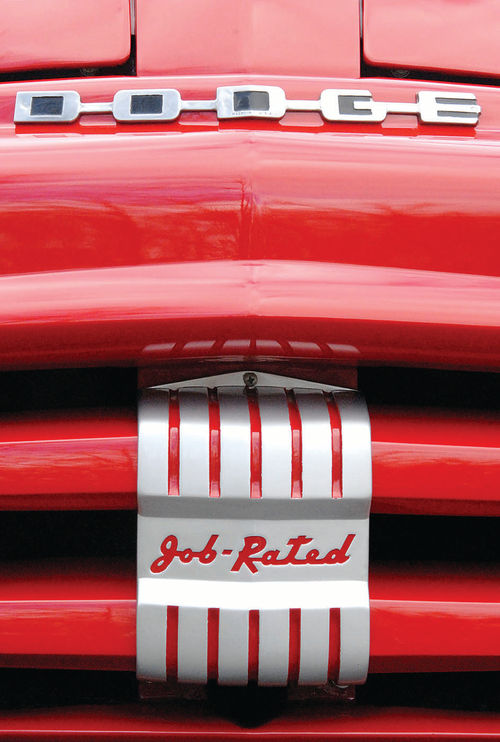1952 DODGE B-SERIES -SERIES PICKUP
It Was a Step Away From the Past and a Move Toward the Future of Pickups. But It Was Never Meant to Be a Deep-Sea Vehicle.
JIM MCGARRY REMEMBERS the first trip in his 1952 Dodge Pickup after he had completed its restoration in 2001.
“It was the South Side Cruise on a Friday night,” he recalled. “I parked it, we walked through the cruise and when I came back, there was a guy in his 20s. He said ‘my dad’s going to buy this truck from you tonight.’ I looked at him and I said ‘OK. Probably not.’ Sure enough, his father came over. It turned out that they had a stone quarry and when he was a kid, they ran Dodges like that.”
Not bad for a truck whose past includes working on a farm, surviving a major flood, being bartered to pay off a bill and more than a decade of sitting before McGarry rescued it in 1993.
But for several reasons beyond personal history, the would-be buyer’s interest is understandable.
The cruise was in Scranton, Pennsylvania — not far from McGarry’s home in Moosic — and while 1948-53 B-series Dodges were once common sights in the area, their tendency to rust did not go well with the salt-covered roads during the generally serious winters there, so those that remain are noticed. They were just as easily noticed in their day, given that they were the first completely new Dodges since before World War II.
A Move Toward Modern Design
The launch of the B-series, an almost completely new truck, came at the start of the 1948 model year. While its drivetrain was a basic flathead six driving through a conventional three- or four-speed as in 1947, even the most oblivious motorist on the road couldn’t overlook the design that minimized or eliminated nearly every prewar styling cue. Only the split windshield and the side-opening hood were retained as the grille was now flat and almost full width, a perfect fit to simple fenders that were much better integrated. Headlights had finally moved into the sheet metal as on Dodge passenger cars of the time and the upper fender lines — the fenders’ complete integration was still in the future — trailed into the doors. Most important, though, was the Pilot-House Cab.
Earlier Dodges, like their contemporary competitors, had cabs that were tight and generally devoid of anything more than the barest comfort features. It’s unfair to compare them to modern pickups, but against the family cars of their time they didn’t come off very well, something that the crop of new postwar trucks sought to address as they began to appear in the late 1940s.
Dodge’s interpretation included practicality as a means to make driving its trucks easier and less fatiguing, so one of the areas targeted for improvement was visibility. The Pilot-House Cab’s windshield was huge compared to that of the previous series’ cab and big enough that a six-footer — who would have been a noticeably tall driver in 1948 — didn’t need to slouch behind the wheel in order to see.
The side windows grew, too, and corner windows at the cab’s rear became an option. Insulation was better, the adjustable seat was wider and even the doors were placed for increased convenience, but the B-series brought some less-visible changes, too. The shortest model’s 108-inch wheelbase was eight inches below that of the corresponding previous truck and that meant better maneuverability, something that was further enhanced by improved steering geometry for a tighter turning radius. Obviously, the longer-wheelbase trucks didn’t share the 108-inch model’s advantages, but the new front end was still a plus for them.
The first real changes in the B-series came in 1950. Some were details, such as the three-speed shifter’s move to the column, but more significant was the availability of Chrysler’s Fluid Drive. A new grille appeared for 1951, the dashboard was redesigned and the 218 six was bumped from 95 to 97 horsepower, so the 1952 models looked almost exactly the same and differed mechanically in incremental improvements.
The B-series as a whole doesn’t always receive the credit it deserves for its innovations and although he’s now a believer, the truck’s place in history didn’t enter into McGarry’s decision to buy the feature vehicle when he was a senior in high school. In fact, the Dodge wasn’t even his initial choice.
Fortunately, the Owner Wasn’t Selling Parts
“I was looking for an old truck for a long time,” he recalled, “and down the road from where I lived was a ’55 Chevy that I was interested in. Fortunately, my parents were kind enough to guide me away from it. It needed so much metal work. It was priced right, but it was just bad metal. It was rough, so I passed on that.”
The Chevy found a buyer, though, and McGarry then noticed the Dodge among a number of vehicles being sold by the Chevy’s former owner. The Dodge might have gotten away, too, as the owner had an offer for its box at the price he was asking for the entire truck, but he chose not to break it apart. McGarry had his chance and he bought the Dodge with an extra tailgate as part of the deal.
“It was pretty complete,” he said. “It was missing running boards, it was missing some of the sheet metal grille pieces on the ends, those four pieces.”
Being complete or close to it is always a good thing, but the truck was not without problems.
“It was wired with house wire,” McGarry said, “but it ran.
“The hood was good; no dents. It had some pitting in it, but otherwise, nice. The front end was good, the front bumper was twisted and needed to be straightened out, so we were able to straighten that out. The fenders, of course, the (rear mounting) bracket collects the mud and that rots it out along with the vertical part by the door. They were in rough shape there.
“The bottoms of the doors were really rough. I would say the skins were really nice, but the bottoms of the doors were rough.
“Then, the cab. The roof and the back other than some dents from missing the box were very solid. Where the cab sits on the frame, where leaves probably collected and it didn’t drain well, that section needed to be replaced.”


Parts of the cab floor around the battery were also replaced, he said, and the only original glass is the pair of corner windows. The rear fenders showed some minor rust along their edges, the tailgate was “workable” and the box itself was straight enough that it’s sometimes taken to be a reproduction by those who see the Dodge today.
The box aside, the sheet metal problems on McGarry’s truck when he bought it were in the areas where rust might be expected on a B-series restoration project and fortunately or unfortunately, the damage on anything but a desert truck is likely to be bad enough to be easily detected.
When Is a Truck a Submarine?
The Dodge might have been in worse condition if not for its odd history. After serving on a farm into the early 1970s, it had the bad luck to go through the flooding that accompanied Tropical Storm Agnes in 1972. It was one of the most damaging floods to hit northeastern Pennsylvania, but how does McGarry know that his truck was underwater?
“It still had all the mud under the fenders,” he explained. “It’s like they pressure-washed it at the car wash, but that was it. It was in the flood, the family sold it in the early ’80s and then a new owner had a carpenter do some work on his house. He couldn’t pay the carpenter, so he traded. The carpenter took the truck and then the carpenter sold the truck to get his money.”
That buyer sold it to McGarry, who said that besides the mud, he found body filler to show that one or more owners had tried to keep ahead of the rust. The good news, though, was that there was no evidence of major accident damage and stripping the body showed that all of the panels appeared to be original. Once he rewired it, he was able to get the truck running well, although it soon began using oil, but it was on the road by 1996.
“That was the first fix-up,” McGarry said. “I worked at a hardware store and that was my toy, so what I made I put into that. But I did it on the cheap.”
A local salvage yard had provided a Jeep seat (for $7) and the green paint wasn’t quite a high-end product. Most of the work was done outside and since the Dodge is a three-quarter-ton B-3-C-116 whose wheelbase is longer than a half-ton’s, there was no easy replacement for the rusted running boards. The solution was wood and that was how he drove it, but after a year or so, a machinist friend suggested that it was time to address the engine.
“So we pulled the motor,” McGarry said, “and he went through it, all new parts, .040-over cylinders, cut the crank, did the whole nine yards. We put it back together…I drove it for not very long and then decided ‘we can make the truck better.’ I was actually going to buy a new project and I said ‘no, I can make this much better.’ In 2000, I proceeded to take it back apart and then went over everything again.”
The restoration was delayed until 2000 because he was working in upstate New York while the truck remained in Pennsylvania and was driven when he returned home on weekends. But another detail fell into place at the same time — an experienced body shop-owner taught him the basics of his craft and with that, the project began.
“That took roughly a year and a half, two years,” he said. “It was pretty much undoing the bodywork I did on the first project.



“During the time that I was working on the motor until the restoration started, I had acquired better body parts. I’d acquired a better set of fenders. I’d bought a complete parts truck and so we stripped that. I bought the front end off of another truck. I was gathering stuff.”
Those running boards were among the most elusive components, but the hunt for them had its entertaining moments. McGarry recalled riding around a salvage yard in a 1970s Lincoln Town Car with the yard’s owner, a man of few words who seemingly knew the location of every possible donor Dodge lurking among the thick vegetation. The owner stopped at various points, directed him through brush and rows of vehicles, but waited in the Lincoln as each of the trucks turned out to be a half-ton. Finally, one set of directions led McGarry to nothing that looked like his truck, so he returned to the Lincoln and reported that there was no Dodge.
“He said ‘you went in the wrong way,’” McGarry laughed. “‘You were supposed to go that way.’ I went in and sure enough, there it was.”
Some of the work was probably easier — or at least more straightforward — than finding the running boards. The kingpins and drag link were replaced; the transmission and rear end needed little more than gaskets and seals, and the heater motor, generator and starter received new brushes.
“They needed to be cleaned up and painted,” McGarry explained. “At that point, you’re taking it apart, so you might as well fix everything, paint everything nice and put it back together.”
Still Some Work To Be Done
The Dodge was back on the road in 2001 and he said the problems that showed up were the minor bugs expected after a restoration and easily remedied. Slow cranking, for example, was traced to new cables installed when a previous owner converted the electrical system to 12 volts and although they were in good condition, replacing them with the proper six-volt cables enabled the engine to turn over as it should. Another problem, though, occurred at random and went on for years.
“You’d be driving down the road and you’d hear what sounded like a lowtoned gun going off,” McGarry said, “like something that was just snapping. I never understood it. I thought it was underneath, maybe having to do with a running board. It just didn’t make sense. Nothing leaked, nothing looked broken, so for years — and I mean years — this ‘pop’ would happen when I least expected it and then when I’d think it was gone or I tightened something, ‘pop.’
Dad To the Rescue
“One day, we were coming back from a car show and at the show I’d had both hoods up. My father was in the passenger seat and lo and behold, the noise happened and at the same time, he saw the hood jump, so he said ‘you’ve got to pull over and check this out.’ That hood, when you put it down, you turn the latch. The fingers are supposed to come down and engage, but what would happen was that the fingers would come down and sit (on the edge) and then it would snap off of that. It was an adjustment, but talk about chasing my tail. When I had the hood up, it would ‘re-cock’ the problem and I wouldn’t know when it would go off. That was one that we chased for a while.”


Realistically, that was minor, too, and it didn’t keep him from driving the Dodge. The earliest trips were “very local” ones just to be safe, but he quickly decided that he was satisfied with the result of the work. Most restorers would probably say that, but most restorers aren’t able to make the comparison that he could make. This was, after all, the truck’s second restoration.
“It felt about the same,” McGarry said, “but with more power on hills. When we took the motor apart to rebuild it, there were seven broken rings.”
By 2002, he said, he was confident enough in the truck to venture farther and the first real trip saw it going to the Antique Truck Club of America’s national meet in Macungie, Pennsylvania. There were no problems and it’s since made other trips, which have revealed that one of its strong suits is economy.
“It gets just under 20 miles per gallon on a nice drive,” McGarry said. “It’s the best fuel-mileage vehicle I own.”
It’s Not a Common Sight
When it does need gas, he said, most of those who talk to him at the pump guess that it’s from the 1950s, but some place it as far back as the 1930s. A few comment on the popularity of the B-series when new, and it might now be enjoying a surge in popularity given that one of the questions he hears at car shows regards parts availability.
“The sheet metal’s a problem,” he said. “Since we built this, they’ve started to reproduce things in fiberglass; if you’re willing to go that route and concede to fiberglass fenders. As far as mechanical parts go, they’re pretty easily available. Electrical parts are available.”
The fact that body panels are being reproduced backs up the idea of growing popularity, but Dodges like his are not yet sufficiently common to blend into the scenery, and McGarry said some drivers stop to photograph it as he’s going down the road. He gave the example of a car he noticed exiting a parking lot as he passed by slowly in traffic.
“She stopped, she got out of her car, stood there with a camera and took a picture,” he said.
Regardless of such paparazzi scenes, McGarry said that buying the truck was the right move and that he plans to keep it. His father, he added, would agree.
“We worked on it together,” he explained. “It’s not only the truck, it’s the memories of the process.
“He enjoys it more than I do. He enjoys going to events, going to car shows and talking about it. He doesn’t drive it as much as I do, but he loves being the passenger. He taught me how to shift it.”
McGarry was 18 when he bought the Dodge and said that when friends would invite him somewhere, he often declined so that he could continue working on it.
So what about that offer from the Dodge fan whose son first approached him at the cruise back in 2001? Does he ask about it?
“To this day,” McGarry said. “I see the same guy at the cruises and he says ‘the offer’s still there. When do you want to sell it?’”
















